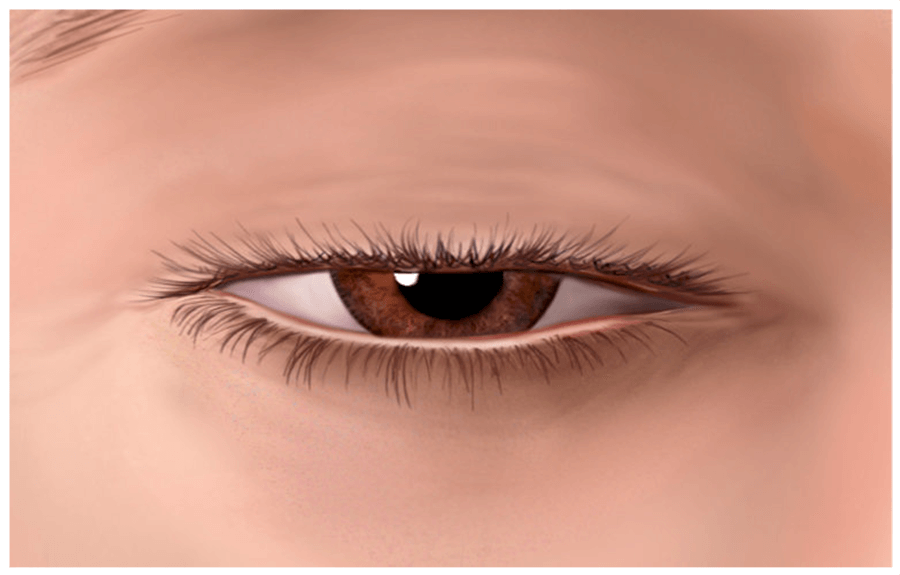Blepharoplasty.
Blepharoplasty (BLEF-uh-roe-plas-tee) is a type of surgery that removes excess skin from the eyelids. With age, eyelids stretch, and the muscles supporting them weaken. As a result, excess skin and fat can gather above and below your eyelids. This can cause sagging eyebrows, droopy upper lids and bags under the eyes.
Besides aging, severely sagging skin around the eyes can reduce side vision (peripheral vision), especially the upper and outer parts of the visual field. Blepharoplasty can reduce or get rid of these vision problems. The surgery can also make eyes look younger and more alert. Learn how blepharoplasty is done and about the benefits and risk of the procedure.
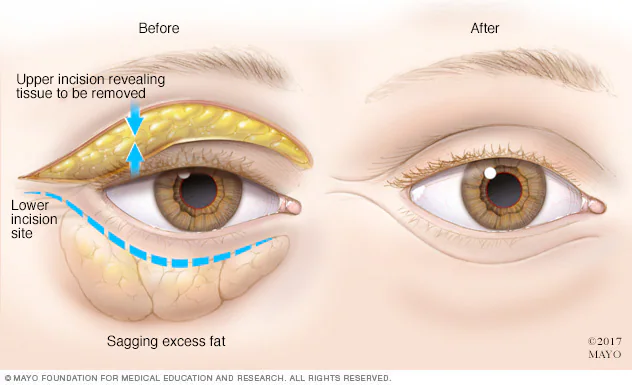
Cataract surgery

Cataract surgery is a procedure to remove the lens of your eye and, in most cases, replace it with an artificial lens. Normally, the lens of your eye is clear. A cataract causes the lens to become cloudy, which eventually affects your vision.
Cataract surgery is performed by an eye doctor (ophthalmologist) on an outpatient basis, which means you don’t have to stay in the hospital after the surgery. Cataract surgery is very common and is generally a safe procedure.
Glaucoma surgeries
Your health care provider will review your medical history and conduct a comprehensive eye examination. Your provider may perform several tests, including:
- Measuring intraocular pressure, also called tonometry
- Testing for optic nerve damage with a dilated eye examination and imaging tests
- Checking for areas of vision loss, also known as a visual field test
- Measuring corneal thickness with an exam called pachymetry
- Inspecting the drainage angle, also known as gonioscopy
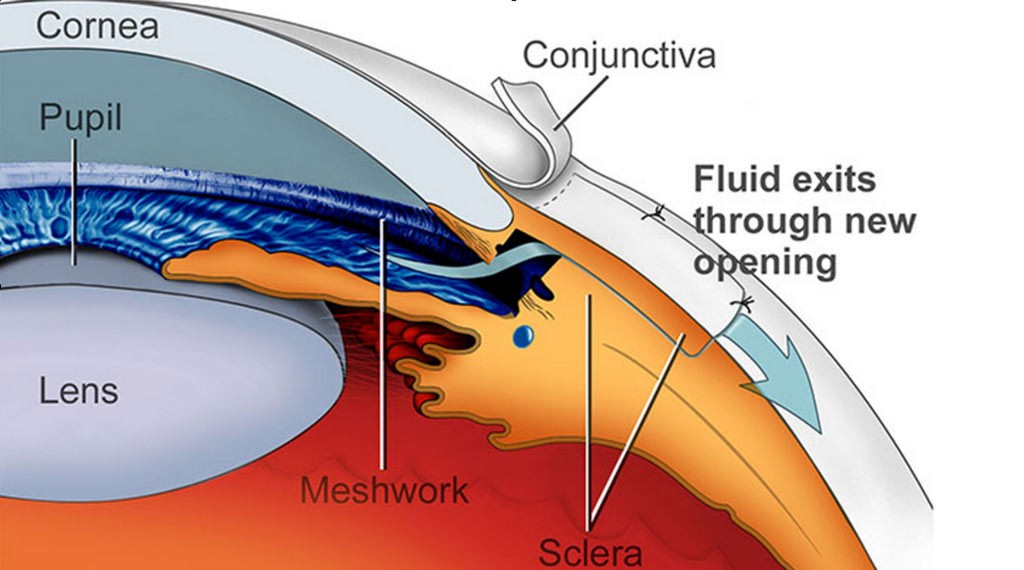
Phakic IOL

A phakic intraocular lens (PIOL) is a special kind of intraocular lens that is implanted surgically into the eye to correct myopia (nearsightedness). It is called “phakic” (meaning “having a lens”) because the eye’s natural lens is left untouched. Intraocular lenses that are implanted into eyes after the eye’s natural lens has been removed during cataract surgery are known as pseudophakic.
Phakic intraocular lenses are indicated for patients with high refractive errors when the usual laser options for surgical correction (LASIK and PRK) are contraindicated. Phakic IOLs are designed to correct high myopia ranging from −5 to −20 D if the patient has enough anterior chamber depth (ACD) of at least 3 mm.
Eye muscle surgery
Eye surgery, also known as ophthalmic or ocular surgery, is surgery performed on the eye or its adnexa, by an ophthalmologist. Eye surgery is part of ophthalmology. The eye is a fragile organ, and requires due care before, during, and after a surgical procedure to minimize or prevent further damage. An eye surgeon is responsible for selecting the appropriate surgical procedure for the patient, and for taking the necessary safety precautions. Mentions of eye surgery can be found in several ancient texts dating back as early as 1800 BC, with cataract treatment starting in the fifth century BC. It continues to be a widely practiced class of surgery, with various techniques having been developed for treating eye problems.
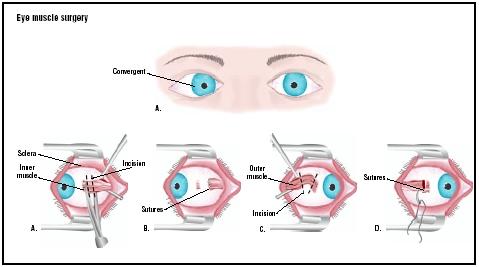
Entropion Surgery

Entropion is a medical condition in which the eyelid (usually the lower lid) folds inward. It is very uncomfortable, as the eyelashes continuously rub against the cornea causing irritation. Entropion is usually caused by genetic factors. This is different from when an extra fold of skin on the lower eyelid causes lashes to turn in towards the eye (epiblepharon). In epiblepharons, the eyelid margin itself is in the correct position, but the extra fold of skin causes the lashes to be misdirected. Entropion can also create secondary pain of the eye (leading to self trauma, scarring of the eyelid, or nerve damage). The upper or lower eyelid can be involved, and one or both eyes may be affected. When entropion occurs in both eyes, this is known as “bilateral entropion”. Repeated cases of trachoma infection may cause scarring of the inner eyelid, which may cause entropion. In human cases, this condition is most common to people over 60 years of age
Ectropion Surgery
Ectropion is a medical condition in which the lower eyelid turns outwards.[1] It is one of the notable aspects of newborns exhibiting congenital Harlequin-type ichthyosis, but ectropion can occur due to any weakening of tissue of the lower eyelid. The condition can be repaired surgically. Ectropion is also found in dogs as an inherited, developmental condition.

DCR

A dacryocystorhinostomy (DCR) is a surgery that creates a new path for tears to drain between your eyes and your nose. You may need this surgery if your tear duct has become blocked. The procedure can be performed externally through an incision in the skin, or endoscopically through the nose without leaving a skin incision. Both methods are equally successful.
Pterigyuim Surgery
Pterygium surgery involves removal of the abnormal tissue from the sclera and cornea of the eye. Today’s techniques offer a significantly higher success rate than conventional surgery.
In traditional “bare sclera” pterygium removal, the underlying white of the eye is left exposed. Healing occurs over two to four weeks with mild to moderate discomfort. Unfortunately, “bare sclera” pterygium surgery has a high rate of re-growth; this occurs in up to 50% of patients. In many cases, the pterygium grows back larger that its original size.
Over the years, surgeons have used several different techniques to lessen the likelihood of pterygium recurrence, including radiation treatment and the use of “antimetabolite” chemicals that prevent growth of tissue. Each of these techniques has risks that potentially threaten the health of the eye after surgery, including persistent epithelial defects (ulceration in the surface of the eye), and corneal melting.

Eyelid mass Surgery
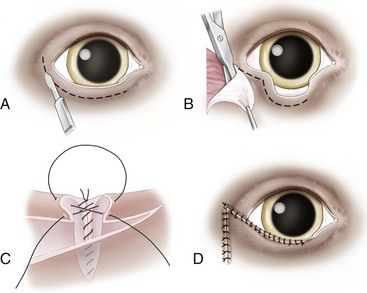
An eyelid is a thin fold of skin that covers and protects an eye. The levator palpebrae superioris muscle retracts the eyelid, exposing the cornea to the outside, giving vision. This can be either voluntarily or involuntarily. The human eyelid features a row of eyelashes along the eyelid margin, which serve to heighten the protection of the eye from dust and foreign debris, as well as from perspiration. “Palpebral” (and “blepharal”) means relating to the eyelids. Its key function is to regularly spread the tears and other secretions on the eye surface to keep it moist, since the cornea must be continuously moist. They keep the eyes from drying out when asleep. Moreover, the blink reflex protects the eye from foreign bodies.
The appearance of the human upper eyelid often varies between different populations. The prevalence of an epicanthic fold covering the inner corner of the eye account for the majority of East Asian and Southeast Asian populations, and is also found in varying degrees among other populations. Separately, but also similarly varying between populations, the crease of the remainder of the eyelid may form either a “single eyelid”, a “double eyelid”, or an intermediate form.
Ptosis Surgery
Ptosis surgery is an operation to tighten the muscle that lifts your upper eyelid.
As you get older, the levator muscle that lifts your upper eyelid stretches and weakens, causing your eyelid to sag.
If you have a sagging eyelid that is interfering with your vision, ptosis surgery can be an effective treatment to improve your vision.
